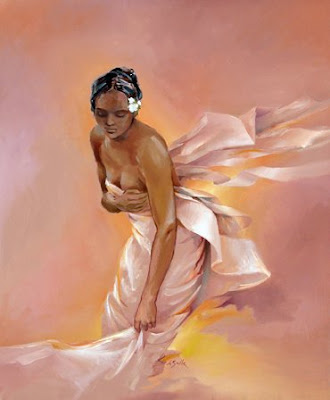 From this point onward, he devoted himself solely to his vocation as a painter. Influences on his career have included the statuary of medieval Burgundy, the Flemish primitives as well as the giants of the Italian Renaissance. Both painter and sculptor, he is also an accomplished draughtsman, engraver and has experimented quite successfully in the field of lithography.
From this point onward, he devoted himself solely to his vocation as a painter. Influences on his career have included the statuary of medieval Burgundy, the Flemish primitives as well as the giants of the Italian Renaissance. Both painter and sculptor, he is also an accomplished draughtsman, engraver and has experimented quite successfully in the field of lithography.The flamboyant Baroque side to his temperment has also led him to venture into the possibilities offered by the theater and opera. He has personally directed operas, designed sets and costumes, written several plays, many poems and composed the lyrics to songs. In 1986, Charles-Louis La Salle was formally invited to be a member of the jury at the Monte Carlo Contemporary Art Festival. Three years later, in 1989 he was once again a jury member, this time at the Avoriaz Festival. It was during this festival that one of his paintings was selected to serve as the cover of the Festival program.
In 1980, Charles-Louis La Salle was awarded the Prize of the Marseilles Academy of Sciences, Arts and Letters. Six years later, he received the Prize of the Monte Carlo Contemporary Art Festival. The Prize of The Jules Verne Foundation followed in 1989.
After spending several years on the shores of the Mediterranean Sea, he discovered the splendors of ancient Provence. This led to his decision to settle on the banks of the Rhône River in a small, picturesque village ideally located within the "Golden Triangle" of Provence--Arles, Avignon and Nîmes. It was here, in an abandoned, XVII century convent, that Charles-Louis created the artistic universe that now corresponds so perfectly to his image and to his work. More than a dwelling, this house must be looked upon as a highly personal work of art.
Working in this new environment of life and creation, he has chosen to explore one the most essential components of his cultural identity: his thoroughly Latin character.
But over the years, new horizons have beckoned to Charles-Louis La Salle. Traveling across the world, he has discovered the Pacific and Tahiti, his "New Cythera" as Bougainville called it. These new sources of inspiration have led him begin writing once again and have fueled an explosion of new themes in both the world of painting and sculpture.
After his "Italian Period", the colors of Charles-Louis palette have varied. Henceforward, his colors have drifted towards the sun...



















1 yorum:
Image not only exceptional, but sums up the emotions of a lifetime.
Have a nice weekend!
Yorum Gönder